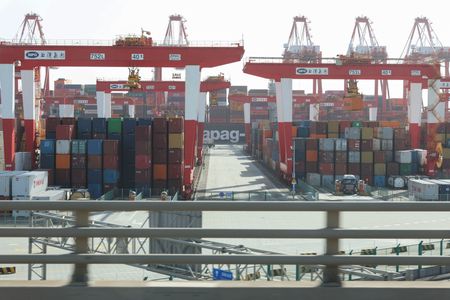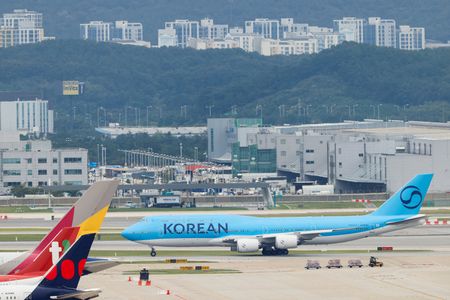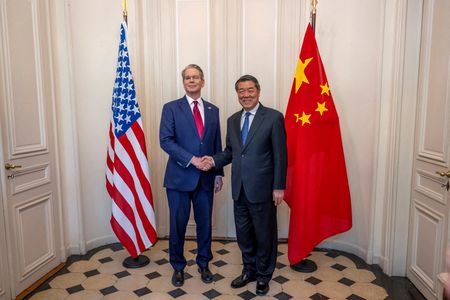By Xiuhao Chen and Ryan Woo
BEIJING (Reuters) – China’s exports rose sharply in March after factories rushed out shipments before the latest U.S. tariffs took effect, but an escalating Sino-U.S. trade war has darkened the outlook for factories and growth in the world’s second-biggest economy.
U.S. President Donald Trump has ratcheted up tariffs on Chinese goods to hefty levels that many economists say will profoundly impact global trade flows and business investment.
Exports rose 12.4% year-on-year, a five-month high, handily beating 4.4% growth expected in a Reuters poll of economists. Exports grew 2.3% in January-February.
Trade uncertainties have rocked financial markets this month after Trump announced sweeping tariffs on many countries on April 2. Trump unexpectedly paused the higher duties on a dozen economies days later, but slapped even stiffer levies on China that Beijing has dismissed as “a joke”.
Economists warn the March export figures will be eclipsed by a fast deteriorating outlook.
“Export growth accelerated in March, as manufacturers rushed to ship goods to the U.S. ahead of ‘Liberation Day’,” said Julian Evans-Pritchard, head of China economics at Capital Economics, in a note to clients.
“But shipments are set to drop back over the coming months and quarters,” he added.
“We think it could be years before Chinese exports regain current levels.”
Trump levied 10% tariffs across all Chinese imports into the United States, effective on February 4, and followed that up with another 10% in March, accusing Beijing of not doing enough to stem the flow of fentanyl into the United States.
Washington’s fresh round of tariffs lift duties on China to an eye-watering 145%, prompting Beijing to jack up levies on U.S. goods by 125% in an intensifying trade war between the world’s two biggest economies.
Monday data also highlighted a soft underbelly in domestic demand in China, meaning policymakers will have their work cut out in trying to guard against any sharp trade downturn.
Inbound shipments fell 4.3%, compared with a 2.0% decrease forecast in a Reuters poll, and an unexpectedly steep contraction of 8.4% at the start of the year.
Markets in China were up modestly, but much of the activity was linked to mixed messages from Trump over the weekend regarding exemptions on smartphones and other electronics. China’s blue-chip CSI300 Index climbed 0.3%.
TRADE IMBALANCE?
China’s March trade surplus was $102.64 billion, down slightly from $104.8 billion in December, the most recent comparable reading.
More importantly, China’s trade surplus with the United States in the first quarter came in at $76.6 billion, up from $70.2 billion a year earlier.
This will likely keep the production powerhouse in Trump’s sights given that improving the trade gap is at the top of his agenda.
Commodities data showed while Chinese imports of crude oil rose in March, those of soybeans, coal, iron ore and unwrought copper dropped.
Imports from the United States may have already been affected by the trade spat.
China’s total soybean imports tumbled by 36.8% in March year-on-year.
“China seems to stop its farming imports from the U.S. altogether already,” said Xu Tianchen, senior economist at the Economist Intelligence Unit.
“Its soybean imports tumbled by around half in March during a high season of China-U.S. farming trade, perhaps because state-owned importers already received the guidance to stop imports,” he said.
FIGHT TO THE END
Beijing has vowed to fight U.S tariffs to the end and protect the economy from “external shocks”, with markets widely expecting authorities to roll out further fiscal and monetary stimulus measures in coming months to underpin growth.
Exports have been a lone bright spot in China’s economy, which has struggled to mount a solid post-COVID recovery as confidence has remained low in the face of a protracted property crisis and deepening deflationary pressures.
President Xi Jinping, in his first public comments on the tariffs, told Spanish Prime Minister Pedro Sanchez during a meeting in Beijing on Friday that China and the EU should “jointly oppose unilateral acts of bullying”, state-run Xinhua news agency reported.
Xi kicked off a three-nation tour of Southeast Asia on Monday, aiming to consolidate ties with some of China’s closest neighbours amid the tariff disruptions.
The World Trade Organization has warned the high-stakes Sino-U.S. trade row could cut the shipment of goods between two economies by as much as 80% and severely hurt global growth.
Goldman Sachs last week lowered its forecasts for China’s 2025 GDP growth to 4% from 4.5%, citing the effects of tariffs. Citi cut its forecast to 4.2% from 4.7% two days earlier. Their revised forecasts are well below the government’s growth target of “around 5%.”
China’s export industry is facing a complex and severe external environment, customs official Lv Daliang said on Monday.
Mounting trade pressure and a dwindling U.S. consumer base have prompted Chinese exporters to assess domestic opportunities.
“The data showed that overall exports remained quite resilient, but that easily replaceable and price-sensitive categories are already taking a hit,” said Lynn Song, Greater China chief economist at ING.
“With a staggering 145% tariffs coming into effect, it’s likely that next month’s data will tell a dramatically different story.”
(Reporting by Xiuhao Chen, Ethan Wang, Tina Qiao and Ryan Woo; Editing by Shri Navaratnam)











